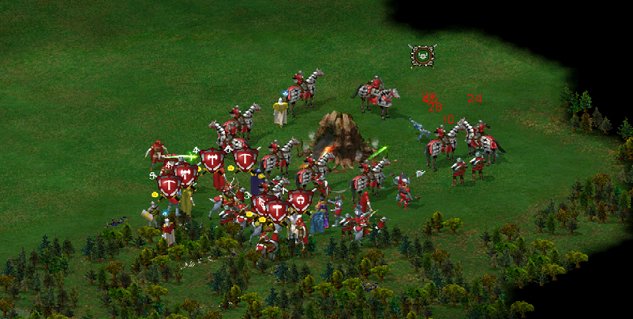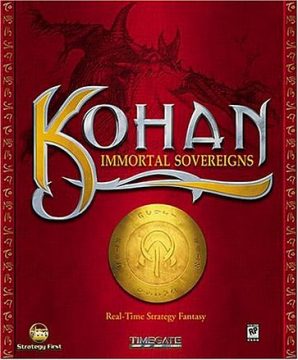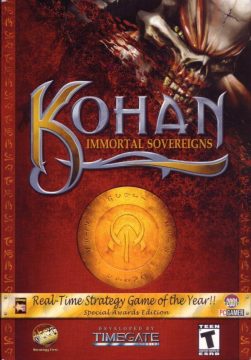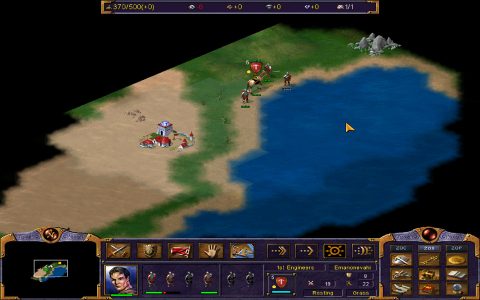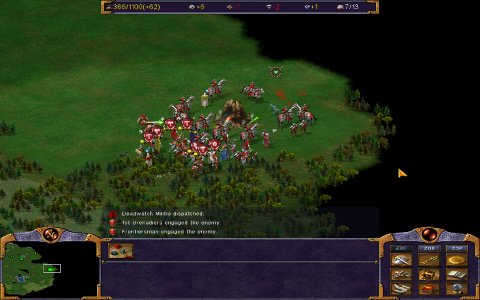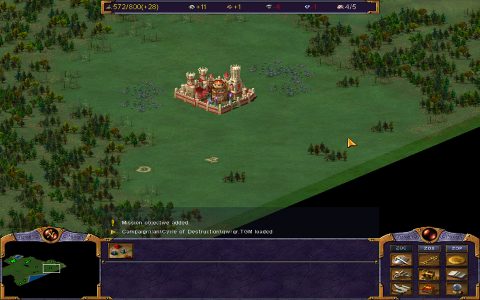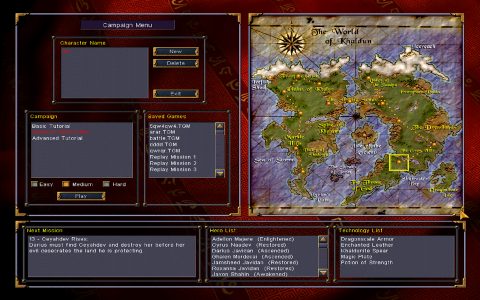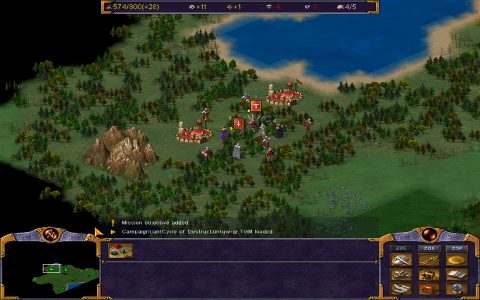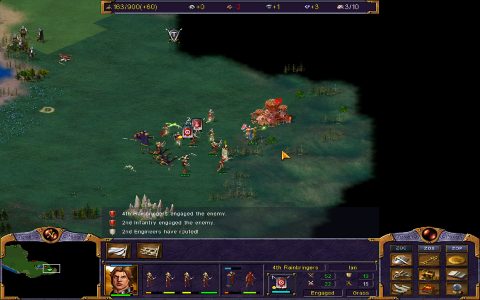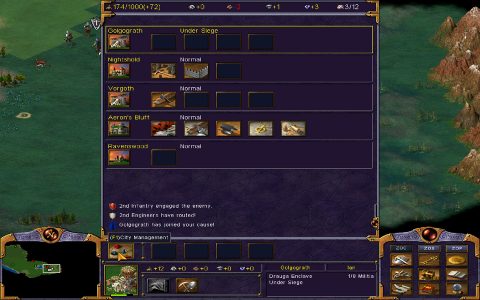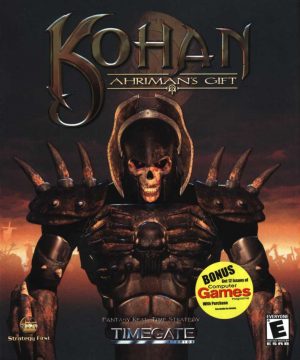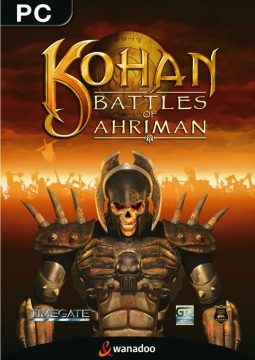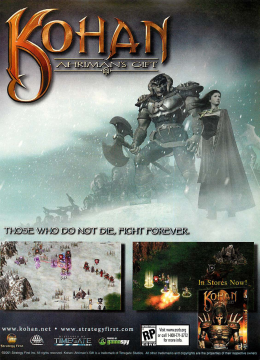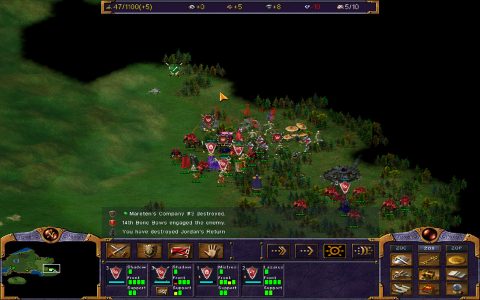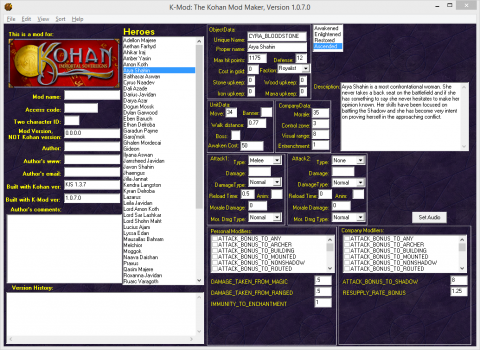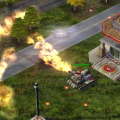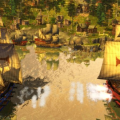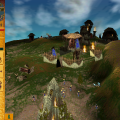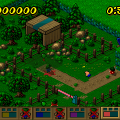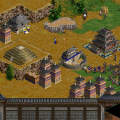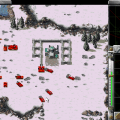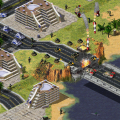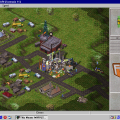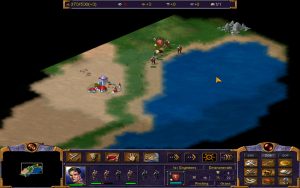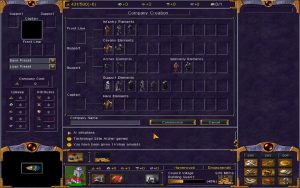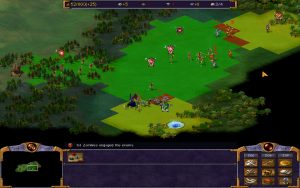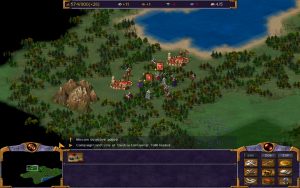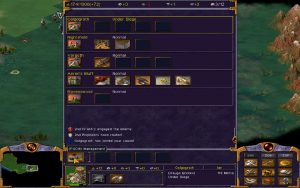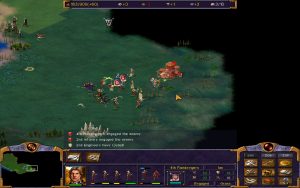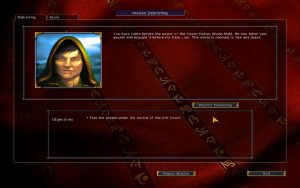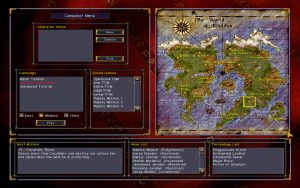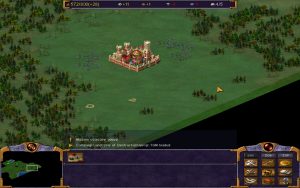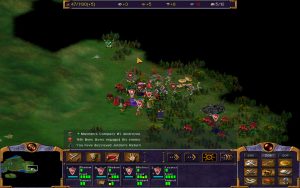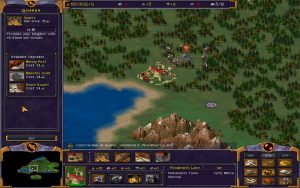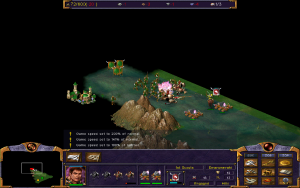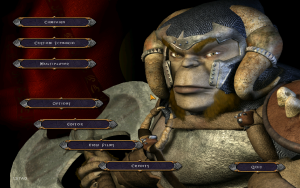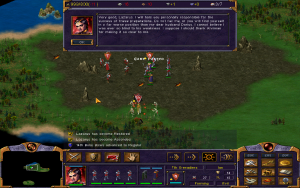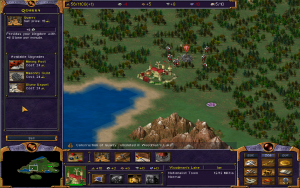- Kohan: Immortal Sovereigns
- Kohan II: Kings of War
Hero units have long been a fraught feature in RTS games, especially in single-player campaigns. Since they’re generally vital to the story, speaking in cutscenes and generally justifying the game, it’s usually necessary to keep them alive – making them a serious liability in battle. Hero death in Warcraft II: Beyond the Dark Portal and Starcraft almost always ends the story – but Warcraft III changed the status quo by more or less adapting the cavalier, respawn-friendly attitude towards death familiar to Diablo players. Nowadays, purely narrative RTS games are fairly rare, and the MOBA phenomenon is a direct result of modders taking advantage of Warcraft III‘s novel hero philosophy.
RTS games have also experimented with economy, even as mostly automated, individually controllable resource-gathering units remain a core feature in the Blizzard model. Both Dune II and its immediate heir, Command and Conquer, feature a single resource collected by autonomous units. Peasants and peons in Warcraft: Orcs and Humans gather lumber and mine gold. In 1995, Warcraft II shook things up a little by adding a third resource, oil, to the familiar gold and wood economy. Age of Empires really raised the stakes – it features four resources, and a vast array of units and buildings dedicated to and relying upon each resource.
But with great economic diversity comes great vulnerability. As any Starcraft player will tell you, managing SCVs, drones, and probes on both a macro and micro level is critical to success. Without a streamlined economy or the ability to avoid harvester losses through quick tactical thinking, victory is impossible. Total Annihilation made resource gathering a function of structures rather than units in 1997, and Cavedog’s Ground Control (2000) emphasized tactical positioning over quick inputs, while eliminating in-mission base-building and unit purchasing altogether. Even so, the bulk of the first decade of RTS games involved a lot of unit babysitting and precision base-building.
Timegate’s Kohan series answers both of these questions with compelling designs that sadly made less of an impact on the genre than they should have. The first two titles, Kohan: Immortal Sovereigns and Kohan: Ahriman’s Gift, combine an innovative economic model with an intriguing take on hero units, resulting in a deeply strategic 2D RTS mostly free of micromanagement. Kohan II: Kings of War drops the languid pace of the first two titles, as well as some neat worldbuilding details, but retains much of what made the originals so great.
All three Kohan titles are easily worth playing – and replaying, for that matter. With decent campaigns, inspiring skirmish and multiplayer modes, and extensive mod support, the Kohan trilogy is as rewarding an RTS experience as you’ll ever find.
Characters
Although the Kohan number in the dozens, they tend to blend together after a while – a selection of significant Kohan follows.
Amon Koth
Father of the foul and fecund Rhaksha, this Ceyah summoner is seldom far from his twisted children. Defeating him is key to purging Khaldun of the Rhaksha menace.
Durash
Not all servants of the Shadow transform against their will. The savage Durash bears more than a passing resemblance to the Darloks of the Master of Orion series.
Yss’Tok
Contemplative where her mate Slyys’Stok is ferocious, Yss’Tok guards the energies of aja – the lifeblood of Khaldun – in battle.
In early 2001, over a year before Warcraft III came out, Timegate Studios released Kohan: Immortal Sovereigns. A race of immortal heroes born to rule – or conquer, as the case may be – the Kohan lead vast armies across the world of Khaldun, with death only a brief setback. If a Kohan’s companions can retrieve the indestructible amulet they leave behind after death, bringing them back to life is a simple matter of performing a quick ritual. 50 gold later, the Kohan is back, good as new – but that’s the problem.
Freshly resurrected Kohan have no memories, relying on the counsel of their friends and the enlightenment of battle to restore the skills they’ve developed over the years. In-game, this is reflected by a complete loss of experience – a serious blow to any army, but not a fatal one. In both multiplayer and the single-player campaign, the show is perfectly free to go on after a major character dies. It’s an elegant design that’s nicely reinforced by the narrative, as the otherwise bland hero Darius Javidan seeks to regain his memories in battle against the corrupted Kohan known as the Ceyah.
The heroic Kohan – all 45 of them – form the kernel of Immortal Sovereigns‘ second major innovation: the company system. In the traditional RTS model, combined arms tactics require carefully-managed unit queues, hotkey assignments, and quick clicking in battle. In Immortal Sovereigns, the basic unit of organization isn’t an individual soldier at all, but a company. A free Kohan can lead any company, replacing the default commander unit, and can be set to engage in melee or stay back and command. In addition to the minimum four front-line troops and a commander, companies can be rounded out by two special units or extra front-line soldiers.
What’s especially brilliant about this system is that not only do companies move and fight as one, but they’re created as one. The makeup of a company is determined at the moment they’re built, and though Kohan can be slotted in and out in the field, the basic makeup of a company never changes. Heroes and support units provide both passive bonuses – to factors like defense, morale, sight range, and speed through difficult terrain – and many can cast spells as well as they can fight. Effective company designs can be saved for quick recall.
Though possibly inspired by Massive Entertainment’s 2000 RTS Ground Control, and certainly a predecessor to infantry dynamics in Relic’s Dawn of War series, companies in Immortal Sovereigns require very little babysitting in combat – not the least of which because Kohan units have no interactive combat abilities. If your Kohan throws fireballs, he’ll do so as long as enemies haven’t closed to melee range. If you have a Channeler in your support slot, they’ll cast Protection and Heal as often as required. And so long as a single unit survives, injured companies will heal near cities or remote fortifications – within the so-called Zone of Supply.
The three zone types play an important role in Immortal Sovereigns‘ design. The Zone of Supply is the infrastructure that keeps armies together. When a company is in supply, as long your economy is healthy and a single unit lives, it will heal back to full – representing recruitment from your empire.
The Zone of Population determines whether or not a settlement can be built in a given space – or whether one is nearby. This can get a little puzzling in multiplayer as you struggle to find space for another city, but some multiplayer modes dispense with settlers altogether.
The Zone of Control represents a company’s projection of force. When a company’s Zone of Control collides with that of an enemy, they become locked into battle. Once this happens, only retreat (controlled withdrawal), flight (emergency escape), routing (flight caused by morale loss), or victory are possible.
Battles thus feel kind of sticky, for lack of a better word. The pacing feels methodical and dramatic, and there’s genuine drama when a high-level Kohan needs reinforcements to cover their escape from certain death. Retreating units suffer extra morale damage, so while changing targets in a traditional RTS is simple, it’s simply not practical in Immortal Sovereigns. One has to either let each battle play out or carefully withdraw and redeploy. Thanks to these mechanics, tactical decisions in Immortal Sovereigns have palpable weight.
Sadly, very large battles and tightly stacked companies show the seams in Immortal Sovereigns‘ company system. Although companies maintain their shape automatically, each sprite still needs room to navigate. Pathfinding issues can cause units to get lost during huge melees and movement near impassable terrain. Though unit loss is easy to deal with when bad planning is to blame, it’s not difficult to set it off by accident.
Nowhere is Immortal Sovereigns‘ tactical emphasis made more clear than in the way that cities and fortifications work. The traditional RTS base is a well-oiled machine where every structure is placed to maximize efficiency and safety for combat units and resource gatherers. In Immortal Sovereigns, however, every city is represented by a single sprite.
Cities in Immortal Sovereigns extend supply, increase the company cap, and defend themselves with completely automated militia. Cities under siege lose supply as militia units sally forth. Once the enemy retreats, supply is restored and the militia return. A company of militia isn’t a real threat to a determined conqueror, but sieges in Immortal Sovereigns are never without risk – because despite only being a single sprite, a fully upgraded city can contain as many as seven structures, many of which can bolster militia performance. Upgrading a city is like speccing a hero – unless you’re well into a match, it’s only possible to build a few structures, and balancing unit prerequisites with economic strength is always a challenge.
With discrete companies, streamlined combat, and self-contained cities, Immortal Sovereigns is clearly dedicated to reducing the tedium of micromanagement – but the Kohan economic model puts the rest of its innovations to shame. On first glance, Immortal Sovereigns‘ economy looks even more complex than Age of Empires. With five resources in play – stone, wood, iron, mana, and gold – you would expect to see an intricate network of peasants and caravans hauling goods from countryside to city. But there’s nothing to see out there but varied and tactically relevant terrain, enemy and neutral cities, wandering monsters, treasure-filled lairs, and the odd resource-providing structure.
Immortal Sovereigns‘ economic system is powerfully simple because resources other than gold just aren’t stockpiled. You could build a lumber mill in every city and put a half-dozen Ironwood Groves in your empire’s Zone of Supply, but all you’ll have to show for it is a huge surplus, which is only as good as what you do with it. With that much wood, you could support a lot of archer units, as well as a few elite Pathfinders – or you could build structures that sell off your surplus, increasing your hoard of gold.
Commission companies or build structures beyond the economy’s capacity, however, and your gold reserves will crash as your empire purchases it from the open market. Stone is the cheapest resource at only 1 gold per unit, while mana shortfalls add up quickly at 5 gold per. Suffice it to say that while fighting a war on steep margins is possible, the strongest army in Khaldun can’t survive an empty treasury.
In most campaign levels, keeping your cities tuned for performance – and prerequisites for your favorite units – is half the fun. Sadly, some single-player missions – especially late in Ahriman’s Gift – hand you expensive units and no economy, transforming what’s supposed to be joyous conquest into a puzzle of which units to disband.
Players can opt to follow Darius Javidan’s path from betrayal to victory in the single-player campaign, but the real meat is found in Immortal Sovereigns‘ substantial multi- and single-player skirmish modes. A generous helping of maps, including inventive scenarios, are included. The random map generator, which supports four themed terrain blends right off the bat, is a delight. By default, early exploration is rewarded with intrinsic tech bonuses, gold, and even the occasional Kohan amulet. Neutral cities and monster lairs – from the troglodytic Rhaksha, to poisonous wasps, to the reptilian Slaan – keep the multiplayer countryside just as lively as the campaign, if not more so.
Are random maps with lairs all that balanced? Not especially. But there’s really something to the thrill of exploration, never knowing what treasure (or Kohan companion) you’ll find next.
Although the world of Khaldun is rife with fantasy standbys like world-shattering cataclysms, amnesiac heroes, armies of the dead, and the like, it’s still fun to explore. Every hero, unit, and monster lair has a bit of unobtrusive flavor text associated with it that illuminates a corner of the world. Voice acting is uneven at best, but captions are always provided.
The campaign doesn’t really explain the political differences between the three Kohan factions and the cities they support, and though they have slight mechanical differences, one can’t help but wonder if there was a more ambitious storyline earlier in development. The Ceyah, on the other hand, are gleefully evil, and raising a demonic army with an upkeep-free core of zombies is a lot of fun.
Kohan: Immortal Sovereigns is a rock-solid RTS with a lot to recommend it. Inspired by critical acclaim, Timegate would waste little time in releasing a sequel – and after that, the curious Kohan: Immortal Sovereigns Special Awards Edition, which omits Ahriman’s Gift but adds 13 heroes to the original cast. Although Immortal Sovereigns and Ahriman’s Gift can be a little difficult to get up and running on Windows 8 and 10, the series is definitely worth a look on Steam.
Kohan: Ahriman’s Gift / Kohan: Battles of Ahriman – Windows (2001)
Released eight months after Immortal Sovereigns, Kohan: Ahriman’s Gift (known as Battles of Ahriman in Europe) is an expandalone that provides a number of incremental improvements over its predecessor. First off, there are more heroes, adding well over 20 Kohan to the four factions. While Immortal Sovereigns only featured a single Darius-focused campaign, Ahriman’s Gift provides three, including one starring the all-new Slaanri Kohan.
The campaigns themselves are reasonably fun, and the Slaanri fit comfortably into the Kohan mythos – not bad at all for palette-swapped monsters. Unfortunately, Ahriman’s Gift‘s prose is much more dense than the first game in the series. New mission introductions, in-game voiceovers, and hero descriptions are very long. Solely on word count basis, Ahriman’s Gift is an object lesson in more not necessarily being better.
By introducing siege engines to the world of Khaldun, Ahriman’s Gift‘s rhythm of play changes significantly. Though incredibly slow, these Khaldunite-powered ballistas expand players’ options in combat, giving an alternative to Engineer companies during sieges. Most importantly, they make battles look cooler.
Mods: K-Mod and SAI
But the true long-term value of Ahriman’s Gift wouldn’t emerge until 2002, when Timegate released the K-Mod tool, and the series would never the same. A wealth of mods remain available until today – from incremental balance updates to popular multiplayer mods like Darkwars, adding dozens of units and spells to the core Kohan experience.
On the evolutionary side of things, some enterprising modders took the opportunity to refine unit and economic balance. Three unofficial community patches for Ahriman’s Gift followed, with the final 1.3.10 version coming out in 2006. Playable in multiplayer and skirmish, though it destroys the single-player campaign, a handy mod selector allows you to switch back and forth as you please.
Immortal Sovereigns and Ahriman’s Gift are also unusual in that they feature a wide variety of multiplayer AIs. Far from the faceless “Easy, Medium, Hard” paradigm that most RTS games offer, each Kohan AI has its own style of play. Thanks to well-commented plaintext data files, players could tweak AI profiles long before Timegate released official documentation, with some players going so far as to run AI leagues to determine whose is the best.
Links:
The Awakening The web’s longest-running Kohan fansite. Surviving the death of Gamespy’s Strategyplanet service, this expansive resource features faction information, strategy articles, and a full archive of mods.
A big thank you to Chimaeros for both maintaining the invaluable resource of The Awakening and graciously allowing me to use his painstakingly captured unit portraits. Immeasurable gratitude goes to Vanessa for editorial and emotional support.
